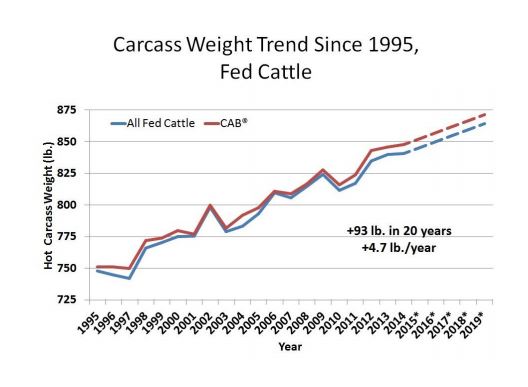



Certified Angus Cattle Are Getting Heavier
Angus producers have a new specification to consider along with established rib eye and yield grade requirements.The US beef industry has a new weight limit on cattle headed for certified angus brand (CAB) labelling - 1,050 pounds.
Prior to 2006, the 1978-established subsidiary of the American Angus Association had no weight limit but relied on a yield grade requirement.
Eight years ago, that was replaced with a ribeye size bracket of 10 to 16 square inches, 1-inch external fat limit and a carcass weight cap at less than 1,000 lb., as part of the brand’s 10 specifications.
Since then, the North American cattle herd continued to decline, and feedlots added more weight to each animal to compensate. U.S. average weekly steer carcass weights recently eclipsed the 900-lb. mark.
“As the beef industry continues to evolve, this brand is actively engaged in discussing ways to maintain increasing relevance to our farmer and rancher owners and licensed partners,” CAB President John Stika said.
Noting the decades-long up-trend in carcass weights (see chart), he said, “Our team has been walking the meat coolers the past two years evaluating our brand within the marketplace.”
CAB Board Chairman for the 2014 fiscal year, Doug Schroeder, Clarence, Iowa, said science has always guided the brand, and data analysis combined with feedback from customers to determine the move and the timing.
“This is a step we could take to ensure the brand remains strong and relevant moving forward,” he said. Product quality and consistency are always the first consideration, Stika said. While the change could mean another 3 per cent to 5 per cent more product from the additional 2,500 to 3,000 cattle at 30 licensed plants each week, the data show the impact on individual cuts will be negligible.
“We looked carefully at the relationship between individual carcass weight and subprimals, finding most of those would increase about a tenth of a pound,” he noted. “I don’t think a 50-pound difference in the whole carcass weight should make a difference to us,” said Kip Palmer, President of Palmer Food Services, Rochester, N.Y. He serves on the CAB Board with Angus producers.
“The price of corn and cattle tells us those weights are just going to keep increasing,” he said, “but the brand specification to keep ribeye size between 10 and 16 inches will still maintain consistency in the boxes.”




